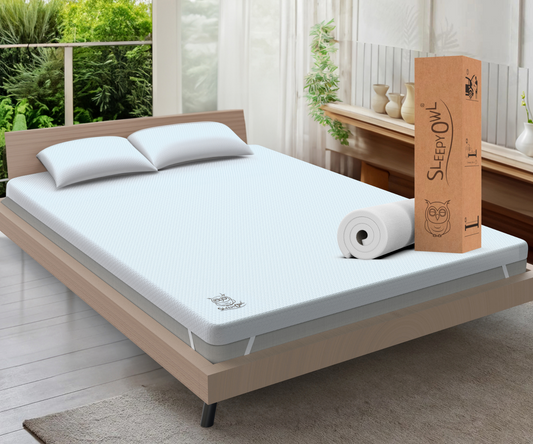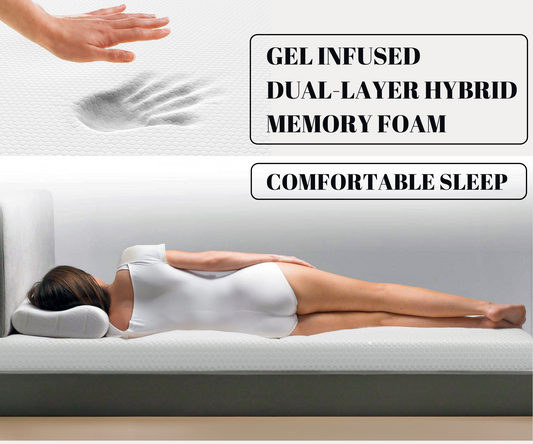The Ultimate Guide to the Best Memory Foam Mattress
Memory foam mattresses have revolutionised the way we think about sleep. Originally developed by NASA in the 1960s to improve seat cushioning for astronauts, this innovative material has since found its way into homes around the world. Memory foam is renowned for its ability to contour to the body, providing personalised support and comfort.
As more people seek better sleep solutions, memory foam mattresses have gained immense popularity, becoming a staple in many households. The unique properties of memory foam allow it to respond to body heat and weight, creating a custom fit that alleviates pressure points. This adaptability not only enhances comfort but also promotes better spinal alignment during sleep.
As a result, many individuals report improved sleep quality and reduced discomfort upon waking. In this article, we will explore the myriad benefits of memory foam, how to choose the right mattress for your needs, and much more. I recently purchased a new memory foam mattress topper for my bed.
Understanding the Benefits of Memory Foam
One of the primary benefits of memory foam mattresses is their ability to provide exceptional support. Unlike traditional spring mattresses, which can create pressure points that lead to discomfort, memory foam evenly distributes body weight across the surface. This feature is particularly beneficial for individuals with chronic pain or those recovering from injuries, as it helps to alleviate pressure on sensitive areas such as the hips and shoulders.
Additionally, memory foam mattresses excel in motion isolation. If you share your bed with a partner, you may have experienced disturbances when they move during the night. Memory foam absorbs movement, ensuring that you remain undisturbed even if your partner shifts positions.
This quality makes memory foam an excellent choice for couples seeking a peaceful night's sleep.
Choosing the Right Memory Foam Mattress for Your Needs
When selecting a memory foam mattress, it is essential to consider your specific needs and preferences. One of the first factors to evaluate is firmness level. Memory foam mattresses come in various firmness options, ranging from soft to firm.
A softer mattress may be ideal for side sleepers who require additional cushioning for their shoulders and hips, while back and stomach sleepers may benefit from a firmer surface that provides better support. Another critical aspect to consider is the mattress thickness. Thicker mattresses often provide more support and durability, but they may also come with a higher price tag.
A standard thickness ranges from 10 to 14 inches, with thicker options available for those who prefer a more luxurious feel. It is advisable to test different thicknesses in-store or through trial periods offered by online retailers to determine what feels best for you.
Factors to Consider When Selecting a Memory Foam Mattress
| Factors to Consider | Description |
|---|---|
| Material | Check the type and quality of memory foam used in the mattress. |
| Firmness | Determine the level of firmness that suits your sleeping preferences. |
| Thickness | Consider the thickness of the memory foam layer for adequate support. |
| Support | Look for mattresses with good support for your body's pressure points. |
| Temperature Regulation | Check if the mattress has features to regulate temperature and prevent overheating. |
| Motion Isolation | Consider how well the mattress isolates motion to prevent disturbances during sleep. |
| Price | Compare prices and consider the value for money offered by different mattresses. |
In addition to firmness and thickness, several other factors can influence your choice of memory foam mattress. One such factor is the density of the foam. Higher-density memory foam typically offers better support and durability but may also retain more heat.
If you tend to sleep hot, look for mattresses that incorporate cooling technologies or gel-infused memory foam to help regulate temperature. Another consideration is the mattress's warranty and trial period. A good warranty can provide peace of mind regarding your investment, while a generous trial period allows you to test the mattress in your home environment.
Many reputable brands offer trial periods ranging from 90 days to a full year, giving you ample time to determine if the mattress meets your needs.
Top Brands and Models of Memory Foam Mattresses
The market is flooded with various brands and models of memory foam mattresses, making it essential to do your research before making a purchase. Some of the top brands include Tempur-Pedic, Nectar, and Emma. Tempur-Pedic is often regarded as a pioneer in memory foam technology, offering high-quality mattresses that provide excellent support and comfort.
Nectar has gained popularity for its affordable yet comfortable options, often featuring generous trial periods and warranties. Emma, a European brand, has also made waves with its award-winning mattress that combines memory foam with other materials for optimal support and breathability. Each brand has its unique features and benefits, so it’s worth exploring customer reviews and expert recommendations before deciding.
How to Care for and Maintain Your Memory Foam Mattress
Proper care and maintenance can significantly extend the lifespan of your memory foam mattress. Regularly rotating the mattress can help prevent uneven wear and prolong its comfort level. It is advisable to rotate your mattress every three months to ensure even distribution of body weight across the surface.
Additionally, using a mattress protector can safeguard against spills, stains, and allergens. Many memory foam mattresses are not machine washable, so a protector can help keep your investment in pristine condition. Regularly vacuuming the mattress surface can also help remove dust mites and allergens, contributing to a healthier sleep environment.
Comparing Memory Foam Mattresses to Other Types of Mattresses
When considering a new mattress, it’s essential to compare memory foam with other types available on the market. Innerspring mattresses are one of the most traditional options, offering a bouncier feel due to their coil systems. While they provide good support, they may not contour as well as memory foam, potentially leading to pressure points.
Latex mattresses are another alternative that offers a different feel altogether. They tend to be more responsive than memory foam and provide excellent breathability. However, they can be heavier and more expensive than their memory foam counterparts.
Ultimately, the choice between these types will depend on personal preferences regarding comfort, support, and budget.
Tips for Finding the Best Deals on Memory Foam Mattresses
Finding the best deals on memory foam mattresses requires some strategic planning. One effective approach is to shop during major sales events such as Black Friday or end-of-season sales when retailers often offer significant discounts. Additionally, subscribing to newsletters from popular mattress brands can provide exclusive access to promotions and discounts.
Another tip is to take advantage of online shopping platforms that allow you to compare prices across multiple retailers easily. Many online brands also offer free shipping and returns, making it easier to find a great deal without compromising on quality. Don’t hesitate to read customer reviews and ratings as they can provide valuable insights into both product quality and customer service experiences.
The Science Behind Memory Foam Technology
The science behind memory foam technology lies in its unique composition and structure. Memory foam is made from viscoelastic polyurethane foam, which allows it to respond dynamically to heat and pressure. When you lie down on a memory foam mattress, your body heat softens the material, allowing it to conform closely to your shape.
This conforming ability not only enhances comfort but also helps distribute body weight evenly across the surface. The result is reduced pressure on joints and improved spinal alignment during sleep. Furthermore, advancements in technology have led to the development of gel-infused memory foams that enhance breathability and temperature regulation, making them suitable for a wider range of sleepers.
Common Misconceptions About Memory Foam Mattresses
Despite their popularity, several misconceptions about memory foam mattresses persist. One common myth is that all memory foam mattresses retain heat and cause discomfort during sleep. While traditional memory foam could trap heat, many modern designs incorporate cooling technologies that enhance airflow and regulate temperature effectively.
Another misconception is that memory foam mattresses are too soft for proper support. In reality, there are various firmness levels available that cater to different sleeping styles and preferences. It’s crucial for consumers to test out different options rather than relying solely on preconceived notions about memory foam.
Making the Most of Your Memory Foam Mattress Investment
Investing in a memory foam mattress can significantly enhance your sleep quality and overall well-being. By understanding the benefits of this innovative material and considering factors such as firmness, thickness, and brand reputation, you can make an informed decision that suits your individual needs. Moreover, proper care and maintenance will ensure that your mattress remains comfortable for years to come.
As you explore your options in the world of sleep products, remember that finding the right mattress is an investment in your health—one that pays dividends in restful nights and rejuvenated mornings. FAQ Section: 1. How long does a memory foam mattress last?
- A high-quality memory foam mattress can last between 7-10 years with proper care.
2. Are memory foam mattresses suitable for all sleeping positions?
- Yes! There are various firmness levels available that cater to side sleepers, back sleepers, and stomach sleepers alike.
3. Do I need a special bed frame for a memory foam mattress?
- Most memory foam mattresses are compatible with standard bed frames; however, slatted frames should have slats no more than 3 inches apart for optimal support. 4.
Can I use my existing bedding with a new memory foam mattress?
- Yes! You can use your existing sheets and bedding as long as they fit the dimensions of your new mattress. 5.
What should I do if my memory foam mattress has an odour?
- It’s common for new mattresses to have a slight smell due to off-gassing; allowing it to air out in a well-ventilated room for a few days usually resolves this issue.
FAQs
What is a memory foam mattress?
A memory foam mattress is a type of mattress that is made from viscoelastic foam, which is designed to contour to the shape of the body and provide support and comfort during sleep.
What are the benefits of a memory foam mattress?
Memory foam mattresses are known for their ability to relieve pressure points, provide support for the spine, and reduce motion transfer. They are also hypoallergenic and can be beneficial for those with allergies or asthma.
How long do memory foam mattresses last?
On average, a memory foam mattress can last between 7 to 10 years with proper care and maintenance. This can vary depending on the quality of the mattress and how it is used.
Are memory foam mattresses suitable for all sleeping positions?
Memory foam mattresses are suitable for most sleeping positions, as they are designed to contour to the body and provide support. However, some people may find that they prefer a different type of mattress depending on their specific sleeping position and preferences.
Do memory foam mattresses retain heat?
Memory foam mattresses are known for retaining heat, as the foam material can trap body heat. However, many modern memory foam mattresses are designed with cooling properties to help regulate temperature and prevent overheating during sleep.





